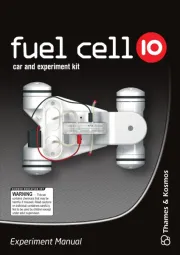Thames & Kosmos Electro Chem Clock Bedienungsanleitung
Thames & Kosmos
Nicht kategorisiert
Electro Chem Clock
Lies die bedienungsanleitung für Thames & Kosmos Electro Chem Clock (2 Seiten) kostenlos online; sie gehört zur Kategorie Nicht kategorisiert. Dieses Handbuch wurde von 4 Personen als hilfreich bewertet und erhielt im Schnitt 4.8 Sterne aus 2.5 Bewertungen. Hast du eine Frage zu Thames & Kosmos Electro Chem Clock oder möchtest du andere Nutzer dieses Produkts befragen? Stelle eine Frage
Seite 1/2

ELECTRO
CHEM
CLOCK
WARNING — Chemistry Set. This set contains
chemicals and parts that may be harmful if misused. Read
cautions on individual containers and in manual carefully.
Not to be used by children except under adult supervision.
Contents
2
EXPERIMENT 1
Starting Up the Lemonade Clock!
Information about Environmental Protection
Safety Notes
Dear Parents! How to Assemble Your Clock
STEP 2
STEP 1
NOTE! Not suitable for children under 3 years of age. There is a danger of choking due to
small parts that may be swallowed or inhaled. Individual parts of this kit have sharp or
pointed edges or corners. Do not injure yourself! Do not drink any of the liquids used for
powering the lemonade clock.
NOTE! Only for use by children 8 years and older. Instructions are included for parents
or other supervising individuals, and they must be followed.
Save the packaging and instructions, as they contain important information.
› Two AA batteries (1.5-volt, type AA / LR6 / penlight) are required. They are not
included in the kit due to their limited storage life.
› Avoid short-circuiting the batteries. A short circuit can cause the wires to overheat
and the batteries to explode.
› Do not mix old and new batteries.
› Do not mix alkaline, standard (carbon-zinc), or rechargeable (nickel-cadmium)
batteries.
› Always insert batteries in the right polarity orientation, pressing them gently into
the battery compartment.
› Do not recharge non-rechargeable batteries. They could explode!
› Rechargeable batteries should only be charged under adult supervision.
› Rechargeable batteries are to be removed from the toy before being charged
› Exhausted batteries must be removed from the toy.
› Dispose of used batteries in accordance with environmental provisions.
› Be sure not to bring batteries into contact with coins, keys, or other metal objects.
› Avoid deforming the batteries.
› The wires are not to be inserted into socket-outlets.
Before beginning the experiments, read through the instruction manual with your
child and discuss the safety notes. Check that the lemonade clock has been properly
assembled before use, and assist your child with the experiments. Have fun with the
experiments!
Guide both digital clock wires through
the holes in the assembly board, as
shown in the illustration.
Position the digital clock on the
sloping section of the assembly board.
YOU WILL NEED:
› Assembly board with digital clock, cup for liquids,
cup lid, 2 copper sheets, 2 zinc sheets,
lemonade or lemon soda
Firmly insert both contact springs
narrow-side-down into the assembly
board. The picture shows the correct
position.
Guide the black wire from the bottom
through the hole next to contact
spring 1. Guide the red wire through
the contact board next to contact
spring 2.
When you bend the contact springs to
the side, it creates gaps in which you
can clamp the ends of the wires.
Clamp the digital clock’s black wire in
contact spring 1 and the red wire in
contact spring 2.
YOU WILL NEED:
› Digital clock, assembly board
with battery compartment, 2
contact springs
1st Edition 2013
© 2013 Franckh-Kosmos Verlags-GmbH & Co. KG,
Pfizerstrasse 5 – 7, 70184 Stuttgart, Germany
This work, including all its parts, is copyright protected.
Any use outside the specific limits of the copyright law is
prohibited and punishable by law without the consent of
the publisher. This applies specifically to reproductions,
translations, microfilming, and storage and processing
in electronic systems, networks, and media. We do not
guarantee that all the information in this work is free
from copyright or other protection.
Project management: Dr. Mark Bachofer, Kristin Albert; Technical
product development: Dr. Petra Müller; Manual design: Atelier Bea
Klenk, Berlin; Basic manual layout: Anke Engelmann, 599media,
Freiberg; Revision and technical editing: Natalie Rapka, reinisch AG,
Karlsruhe; Manual and packaging photos: ilker canikligil (water
drops), atoss (lemon), ApostolPetr (atom, all © shutterstock.com); jufo
(water tap), Markus Mainka (bottles, both © fotolia.com); Alessandro
Volta painting, unknown artist, Wikipedia, public domain; Manual and
packaging illustrations: Phil Porter, reinisch AG, Karlsruhe; Packaging
design and layout: Peter Schmidt Group GmbH, Hamburg
1st English Edition © 2013 Thames & Kosmos, LLC, Providence,
RI, U.S.A.
® Thames & Kosmos is a registered trademark of Thames &
Kosmos, LLC.
Editing: Ted McGuire; Additional Graphics and Layout: Dan
Freitas
Distributed in North America by Thames & Kosmos, LLC.
Providence, RI 02903; Phone: 800-587-2872;
Email: support@thamesandkosmos.com
We reserve the right to make technical changes. Printed in China / Imprimé en Chine
›
Digital clock
›
2 Copper sheets
›
2 Zinc sheets
›
Cup for liquids
›
Cup lid
›
Assembly board with battery
compartment
›
2 Contact springs
You will also need:
› Lemonade or lemon soda
› Paper towels
› Various liquids
› 2 x AA Batteries (1.5-Volt, type
AA / LR6 / Mignon)
1
1. Fill the two chambers of the cup with lemonade
or lemon soda up to about 1 cm beneath the rim.
This will be your battery’s conducting liquid.
2. Put the lid on the cup. Slide one reddish copper
sheet and one silver-colored zinc sheet through
the slits of each chamber.
3. Mount the cup on the assembly board as shown in
the illustration. Clamp the cup’s black wire into
contact spring 1 and the red wire into contact
spring 2.
None of the electrical or electronic components in this kit should be
disposed of in the regular household trash when you have finished using
them; instead, they must be delivered to a collection location for the
recycling of electrical and electronic devices. The symbol on the product,
instructions for use, or packaging will indicate this.
The materials are reusable in accordance with their designation. By reusing or
recycling used devices, you are making an important contribution to the protection
of the environment. Please consult your local authorities for the appropriate
disposal location.
Now your clock will start running! You will see
numbers and blinking double dots appear on
the display.
CAUTION!
Do not let the sheets touch each
other! The pair of sheets connected by the red
wire must not be inserted together into a single
chamber.
WHY As soon as the electrodes are immersed into the liquid, they
release positively-charged metal ions from the sheets due to the action of the
acids in the lemonade, getting back negatively-charged electrons in return.
These electrons are then able to move freely in the metal.
That happens in the copper as well as the zinc, but there’s an important
difference. The copper atoms are very reluctant to accept back any electrons,
while a lot of electrons collect very quickly in the zinc sheet.
Now, if you connect the two sheets, it closes the electrical circuit. The excess
electrons move from the zinc electrode to the copper electrode. Electrical
current flows!
Would you like to know what electrodes, ions, and electrons are? Then take
a look at the “Check It Out” section!
Contact spring 2Contact spring 1
1
2
3
EXPERIMENT MANUAL

ATOMS, IONS,
AND ELECTRICAL
CHARGE
All the substances that make up our world,
such as air, water, and rocks, are made of tiny
building blocks known as
atoms.
For a long
time, scientists thought that these building
blocks could not be broken down any farther,
although we know better today.
In fact, atoms are composed of even smaller
particles. These include a nucleus, which
contains positively-charged protons, around
which fly tiny, negatively-charged
electrons.
Normally, an atom has an equal number of
protons and electrons, meaning that it has
neither a positive nor a negative charge — in
other words, it is
electrically neutral.
If the number of electrons doesn’t match the
number of protons, the atom has a positive
or negative
charge.
A charged atom is
known as an
ion.
EXPERIMENT 3
EXPERIMENT 2
How to Set Your Clock
Does It Have to Be Lemonade?What Does the Display Show? Battery Power for Your Clock Check It Out
Under the display, you will
see two buttons:
A
and
B
.
Your clock has two display
modes:
WHO INVENTED THE
BATTERY?
The first working battery, a so-called
voltaic
pile,
was built around 1800 by the Italian
scientist
Alessandro Volta.
This highly
significant invention in turn made it possible to
conduct research into electricity.
Start by releasing all wires from the contact
springs and pulling them out through the
assembly board from underneath. Remove the
contact springs from the assembly board. Pull
the metal sheets out of the cup of liquid and rinse
them off. Take the cup off of the assembly board.
Pour the liquid from the cup down the drain.
Rinse out the cup and clean the sink to avoid any
stains.
Dry all the pieces with a paper towel and place
them back in their packaging.
Time Display
This shows the time on the display, in hours and minutes. When you push
B
, it
shows a date display — the month and the day. After a few seconds, the time will be
displayed again automatically.
Alternating Display
By pushing
A
, you switch to the alternating display. At a rate of once per
second, the display will alternate between time and date. Then, if you push
B
,
the seconds will be shown.
If you then push
B
again, it takes you back to the time display.
By pressing
B
, you can set the current hour. The displayed number increases by
1 with every push, and switches back to 1 after 12.
You will see that there is a letter A behind the number, which stands for a.m. or
morning. After you press 12 times, the letter switches to P — for p.m., or afternoon/
evening.
You will have to be sure to set the letter correctly depending on whether it is, say, 8
in the morning or 8 in the evening.
YOU WILL NEED:
› Assembled board with digital clock, water,
paper towel, 2 x AA batteries (1.5-volt, type
AA/LR6/penlight)
Now you just have to insert the two batteries
into the battery compartment. Make sure that
the
+
and
-
signs on the batteries match up
with the signs in the compartment.
STEP 1
STEP 2
Insert the two contact springs into two holes
next to the battery compartment.
Guide the black wires next to contact spring 1
through the assembly board holes from beneath
and the red wires in the same way to contact
spring 2, as shown in the illustration.
Connect the black wire from the battery
compartment and the black wire from the digital
clock to contact spring 1 and the red wire from
the battery compartment and the red wire from
the digital clock to contact spring 2.
Press
B
again in order to set the minutes. The displayed number increases by 1
with every push, and switches back to 00 after 60.
Press
A
This takes you to the month setting mode.
Press
A
This takes you to the day setting mode.
Then press
B
to get the correct day.
The displayed number increases by 1
with every push, and switches
back to 1 after 31.
If you then press
B
, you can set the display to the current month. The
displayed number will increase by 1 each time you press, and switches to 1
(January) after 12 (December).
IMPORTANT To set the date and time, you have to switch the clock
to the alternating display mode.
WHY The clock runs because you have now replaced the lemonade
battery with ordinary batteries. The ordinary batteries supply electricity to
the clock just like the lemonade battery did.
Press
A
This takes you to the hour setting mode.
Press
A
This takes you to the minute setting mode.
Press
A
Now the correct time is shown on the display.
CAUTION!
Be sure to have an adult
check that you have connected all the
wires correctly!
YOU WILL NEED:
› Assembled board with digital clock, water, paper towel, various liquids (for
example, diluted vinegar, cola, fruit juice)
1. Start by disconnecting the two metal
sheet wires from the contact springs.
Remove the metal sheets from the
liquid cup and rinse them off. Take the
cup off the assembly board and pour
the lemonade down the drain. Rinse
out the cup and clean the sink to
avoid any stains.
Dry all the pieces with the paper
towel.
2. Then fill the two chambers of the cup
with some other liquid, up to about 1
cm beneath the rim.
Which liquids work to make your clock
run? Write them down here!
THE MOST
IMPORTANT PARTS OF
YOUR BATTERY
The metal sheets immersed in the
lemonade are the so-called
electrodes
of the lemonade
battery. It is crucial that they are
made of different materials. The
electrodes in this kit are made of
copper and zinc.
The lemonade is the battery’s
conductive liquid, also known as
an electrolyte.
It has to contain a
little acid for the battery to work.
Most soft drinks contain some citric
acid.
TIP
!
The electrons react with the positive zinc particles in the conductive liquid.
That gradually creates a layer of zinc on the copper electrode. When that happens,
no more current can flow, since both electrodes outwardly consist of the same
material.
You can get the current flowing again by cleaning the metal sheets with
a little sandpaper and using a new batch of lemonade.
Contact spring 1 Contact spring 2
B
3. Close the cup with the lid and insert
the metal sheets through the slits as
described in Experiment 1.
4. Re-mount the cup on the assembly
board and clamp the wires into their
proper contact springs.
A
1
2
Produktspezifikationen
| Marke: | Thames & Kosmos |
| Kategorie: | Nicht kategorisiert |
| Modell: | Electro Chem Clock |
Brauchst du Hilfe?
Wenn Sie Hilfe mit Thames & Kosmos Electro Chem Clock benötigen, stellen Sie unten eine Frage und andere Benutzer werden Ihnen antworten
Bedienungsanleitung Nicht kategorisiert Thames & Kosmos
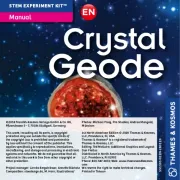
6 August 2025

6 August 2025

3 August 2025

2 August 2025

2 August 2025
Bedienungsanleitung Nicht kategorisiert
- Astro
- Wiltec
- Napoleon
- Cilio
- Agfa
- Carry-on
- 4smarts
- Vax
- Oras
- Winchester
- Traeger
- Duromax
- ESX
- Revier Manager
- MXR
Neueste Bedienungsanleitung für -Kategorien-
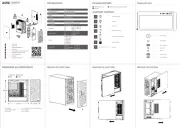
7 August 2025
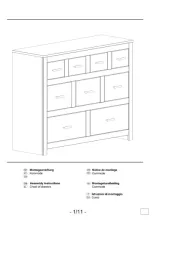
7 August 2025
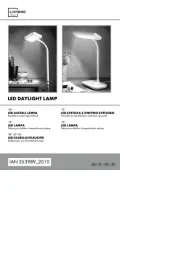
7 August 2025
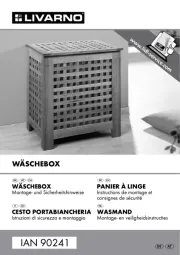
7 August 2025

7 August 2025
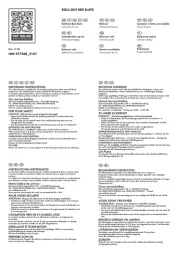
7 August 2025
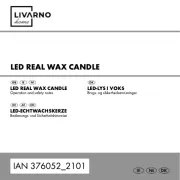
7 August 2025

7 August 2025
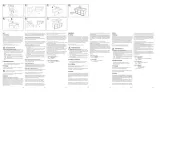
7 August 2025

7 August 2025
